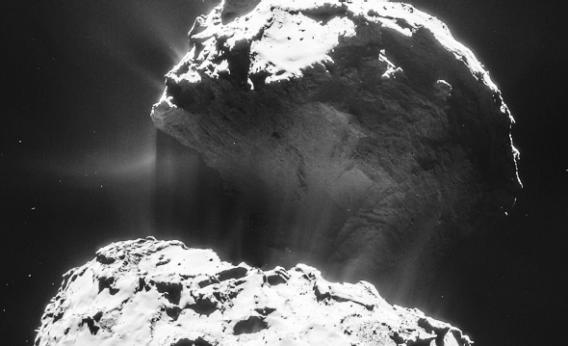Create a free profile to get unlimited access to exclusive videos, sweepstakes, and more!
A Comet’s Gorgeous Aura

A new photo of the comet 67P/Churyumov-Gerasimenko has just been released by the folks working on the Rosetta mission, and holy freaking wow is it gorgeous:
That’s a mosaic of four separate images taken using the NAVCAM detector camera, Rosetta’s low-resolution detector, when the spacecraft was just under 29 kilometers from the comet.
The rubber duckie–shaped comet has two lobes connected by a neck; the smaller lobe is at the top, and the larger lobe at the bottom. I increased the brightness of the image a small amount, accenting the streaks of vapor emitted from the comet; those are jets of gas erupting from the surface! The comet is a mix of ice and rock, and when the ice warms from sunlight, it turns directly into a gas, venting into space.
Rosetta’s detailed images allow us to see that process in detail for the first time. The gas is emitted from various places all over the surface, and over time this changes the comet’s structure and appearance.
For example, at the bottom of the image is a large, round depression (inset here). You might think that’s an impact crater, since those are common on asteroids and the like. But it’s actually a pit formed from leaking gas. Note the shadows in the pit’s floor; the rim is extremely jagged and spiky; those shards look to be dozens of meters high at least. They must be very fragile, and relatively young, or else they’d have long since been destroyed. You can also see rubble in the floor, probably debris that’s rolled downhill as the pit walls have eroded.
I’ll note there are white specks all over the image; I strongly suspect those are cosmic ray hits to the detector, subatomic particles in space that slam into the chip and leave behind a blip.
The detail and contrast in the image is spectacular. And it’ll get better: Rosetta took this image shortly before breaking orbit; over the next few weeks it’ll approach and recede from the comet to measure the environment around it at various distances. On Saturday it will dip down to an astonishing 6 kilometers above the comet’s surface! At that distance, details as small as half a meter should be visible…in the low-res detector. Unfortunately, the OSIRIS high-res camera images aren’t released quickly, so it may be a while before we see them.
And one final thing, something I can’t shake: Does anyone else see the upper lobe being a very creepy and skeletal E.T. looking up and to the left?


























